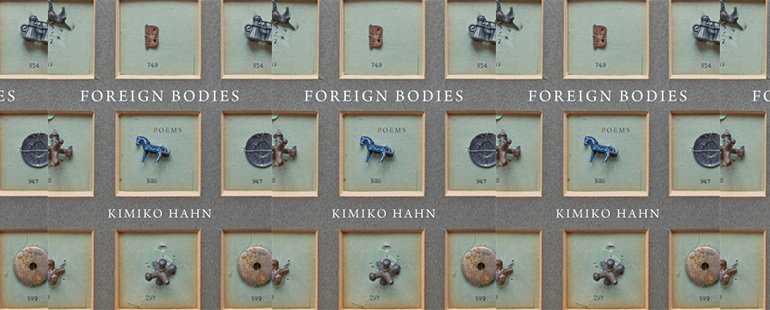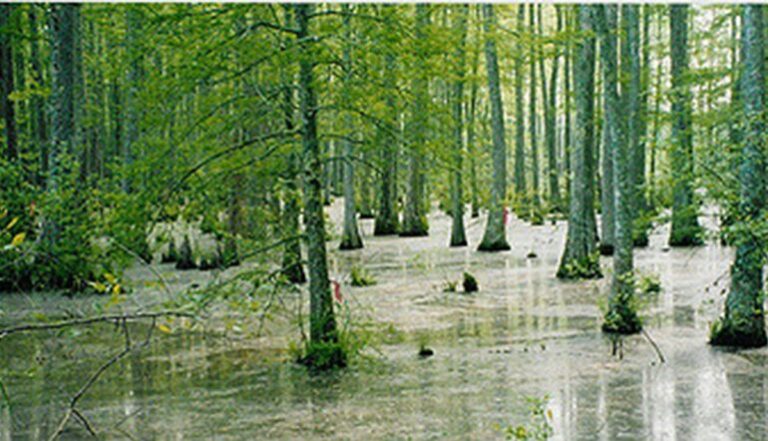Kimiko Hahn’s Sincere Assemblages

At the end of Kimiko Hahn’s tenth collection of poetry, Foreign Bodies, is a contextualizing afterword titled “Nitro: More on Japanese Poetics,” which thoughtfully introduces or extends the reader’s understanding of Hahn’s present poetics: her predilections for play with sound and meaning, her internalization of “productive ambiguity” from the Japanese formal literary tradition, and the nettled intricacies of its translation. Perhaps most importantly, Hahn claims the opportunities of “paronomasia, that fancy term for puns,” as her primary source of poetic “arousal.” “I want to place the craft of poetry back where it belongs,” she determines, “that is, not just party to the mind, but a thing coursing throughout the body. Riotous and iambic. Other times, faint,” signaling fealty to a somatic poetics, and further, to “resist easy context and linear thinking.” The spectrum of the pun to the association is a powerful one, as it channels semantic possibilities into which Hahn pivots—a word she implements from the Japanese literary tradition—sometimes playfully, others elegiacally. Most importantly, “Nitro” establishes the juncture, fitted by Hahn, in which she wants most to be read—rather than waiting, Hahn generously demonstrates how her sensibility is formed by the generativity of Japanese vocabulary and poetry as well as a tradition of English-language formalism. We might understand Hahn’s use of the pivot-word as a skeleton key, in a sense, for her notion and desire for experiential poetry, or for her work to produce an experience, as her “wish is for the reader to experience odd shifts in awareness.” Foreign Bodies, with its surprising associative verges, long sequences spliced with “charms,” or quatrain-ish small poems, and its orientation around particular objects and their relations, provides precisely that desired reading experience. “Nitro” itself, then, is an object lesson, and an entirely welcome one.
The emotional premise for Foreign Bodies is the occasion of cleaning out a father’s house, which had been, before the untimely death of a mother, the speaker’s childhood and family home. An artist, a magpie—a collector verged, it appears, on being a hoarder—the father recurs as a reclusive, eccentric figure, one who perhaps never recovered from the traffic accident which killed his wife decades ago. There needn’t yet be a direct elegy for him, especially as many of Hahn’s poems take place in grief’s resonance of having lost her mother. Instead, as Hahn inhabits here, some losses begin before loss. This situation presents a recovery project of sorts, but not one especially asked for, and not one that is easy to get right. In the second poem with “object” as part of its title, “Constant Objection,” Hahn’s speaker acutely laments, “if only I’d saved your brush / with a few strands of silver hair. // Mother, dear object of my despondence, What more can a daughter bear?” We know that we will, in all likelihood, attend to the material circumstances of our parental figures after their death. But I am not aware of many collections of poetry whose unifying emotional principle revolves around this subject, or, what’s more, builds so intimate and roving an intellectual project out of this otherwise extraordinarily painful task. An encounter with a single object—let alone a house full of them—produces whole narratives, or slippages and scenes, from its previous circumstance, the body to whom the necklace belonged, the speaker’s cherished image of it. Not quite mnemonics—closer to portals—it would be a separate project just to list the specific nouns that populate Hahn’s collection, in both senses of the word.
The question of a collection whose various subjects are assembled, rather than logically produced, is less what they have in common; it is instead what they make in common. What these poems have in common is the interest of the statistician. What they make in common is interest in connections between objects in life—that of relation, or that of art. Given this, it is important to note the absence of a poem that explicitly takes after a still life painting—there is instead “Likeness: A Self-Portrait,” the collection’s most formally dynamic, caesura-saturated sequence in which Hahn splashes analogically—“Like Professor Sara Lewis” pairing with the next stanza’s opening “Like a female firefly,” turning to two “unlike male fireflies” alongside other comparative likenesses—a mode reminiscent of Hahn’s 2010 collection Toxic Flora. In this context, Hahn delivers some of her most electric, hovering lines: “pay attention to attention”; “I take her in to ward her off.” Putting disparate things in context with each other allows Hahn to draw discursively ever closer to detail, which persistently fastens her interest. It follows, then, that Hahn uses related but distinct strategies for organizing likeness and its possibilities, a common point of attraction between things, or elements, animals, plants, and people. Like likes: a near homonym, or a word with the same sound or spelling that means different things. The analogy, or plural things in syntactic or logical connection with each other, also occasions thought and feeling: a poem. The analogy is like a relationship.
All of these things, consequently, are material, add up. Hahn tracks varieties of attractions to things plus the practical question of, really, how to live with them all—“[h]ow to store the object of your ardor, even to stay what harms / (junk drawer, purse,…flash drive)?”—in seeking to understand a magnetism between a thing, its meaning, and the individual’s particular interaction with it. This inquiry motivates “Object Lessons,” the first of the long sequential poems of Foreign Bodies, and it is also the homonymic source of the collection’s title: firstly, any object swallowed becomes a medical term. “Bodies” mutually invokes the human; so, too, the related term “bodies of water,” which is but one link to the oceanic and presence of tidal pools throughout Foreign Bodies. Hahn’s formalism allows homonyms the space to resonate with and against their placements in a line, or in their several meanings simultaneously evoked. Similarly, her associations—perhaps her most reliable mechanism for movement within a poem sequence—are rarely so private as to be untrackable. I can think of only one or two moments in which I could not string a connection between two divergent phrases. The other kind of associative move Hahn uses is a more analogic one, which is how she accommodates likeness at historical scale.
By initiating a historical dialogue as “Object Lesson” from, not after, Dr. Chevalier Quixote Jackson, the “nineteenth-century laryngologist who // removed from tiny upper bodies / an involved collection of objects,” Hahn positions herself as somewhere between poet-surgeon, poet-archaeologist, and, indirectly, poet-subject, understanding, too, the child’s instinct and fundamental oddness of wanting to swallow objects so as to “[s]afe-keep sincere assemblage // by stowing in a ribcage.” Dr. Jackson archived a career’s worth of objects he removed from the children who had swallowed them, a collection famously displayed at Philadelphia’s Mütter Museum. Likeness works a lineage of things through such ingestion: like the doctor himself and his childhood, Hahn writes, “each child had hoarded some thing // in her inmost chest.” My sense is that the feeling of loss, for Hahn, is something that even poetry cannot extract. In thirteen parts, “Object Lesson” sets in place the collection’s relationship between of the long poem and the “charm” poems, which, in the context of objects, echoes the activity of peristalsis, reminding the reader of the bodily nature of words: they are held both in the mind and in the throat before they are spoken. With their Dickinsonian mood and enigmatic directives—“When you spy a horseshoe crab / Flipped over on the shore…” (you’ll have to read the poem to know what to do next)—these charms are lyrics whose meaning is not so easily digestible but intuited.
While mostly written toward the poetry of the long eighteenth century, Crystal B. Lake’s Artifacts: How We Think and Write About Found Objects offers a way to consider the work of Foreign Bodies and its interest in the fossil, the souvenir, the memento. Technically speaking, all of these things and, I venture, these poems, function as vibrant artifacts, their meaning inhering in their ability to occasion interpretation as things, as much as they are about things. Moreover, Foreign Bodies, in balancing the historical imaginary and the present-day elegy through its encounter with such a variety of things, aligns with Lake’s idea of “artifactual form,” or commonalities in literary texts that talk about artifacts. Let’s not forget Hahn’s above declaration that poetry is, itself, a thing felt in the body (which is, for Hahn, also an object). Lake found in her study of antiquarian literature that texts representing artifactual form
encoded networks of referential allusions that make it difficult to classify them as either fiction or nonfiction. They demonstrated a commitment to mimesis, imitation, or unity while they also questioned the viability of such commitments. They presented themselves as the unwilled effect of objects that appeared to be prior or external to the texts themselves. They exhibited affective ruptures over the text’s failure to fully depict what it aimed to represent. And they shared an interest in historical, political, and philosophical topics.
By the inclusion of historical poems intertwining, for example, the fascinating backstory of the real-life girl brought forward in “She Sells Seashells: Considering The Life of Mary Anning” and Hahn’s own responses to it, we can begin to see how artifacts—in this case, fossils found on an English beach in the early nineteenth century—determine the shape, range, and reach of the poems concerning them in Foreign Bodies. Yet these are emotional dimensions more than anything else, Hahn reminds us, as she associates between Mary’s origin story and her own early fear of lighting matches: “…I twisted, shrieked, and wept. But // the penniless Annings scraped by / against the raw ocean air.”
On the beach, that liminal space well-suited, analogically speaking, to grief—the known land and the unknown sea—Hahn also finds a kind of resolution in repetition, in the shared materiality in the ongoingness of family bodies. Where earlier, Hahn writes of her mother’s ashes, “I’ll soot be with her— // elegiac and original,” pressing that slippage between soot, soon, and soothe, Foreign Bodies returns, in its last poem, to the “Haiku beach / that shoreline of sugarcane ash // where Grandma gave birth to Mama,” as Hahn hears while snorkeling an “iambic whoosh,” that “I imagine as the sound of death but really // it’s my breath,” the expansion of a homonym in the form of a generative echo, that same sound “whooshing in utero // of the daughter of my daughter.” From within such intimacies of relation, embodied alternately in self, family, things, or memory itself, Kimiko Hahn’s Foreign Bodies delivers us an object lesson in the true reckoning still possible to us in poetry’s form.
This piece was originally published on May 18, 2020.


